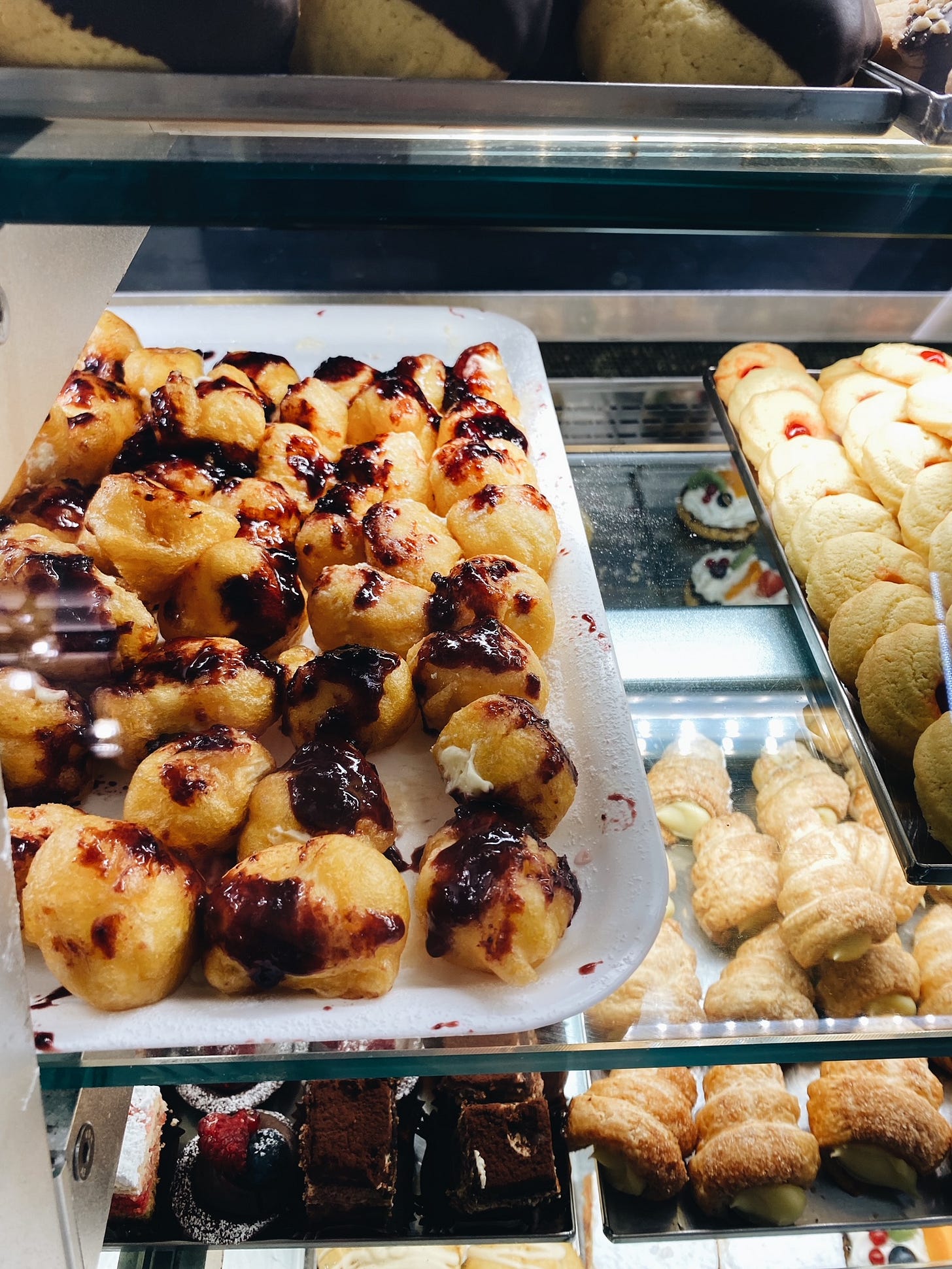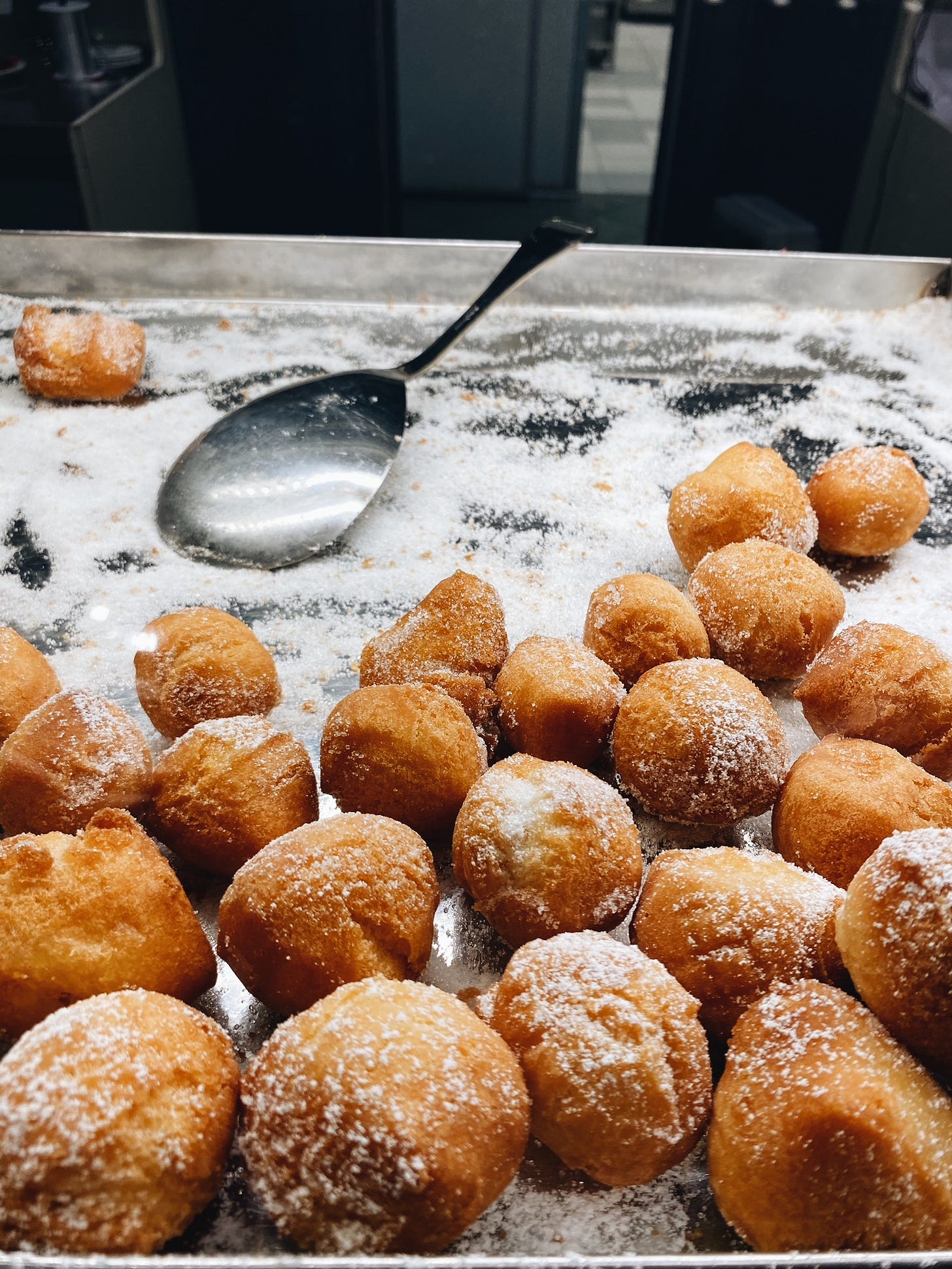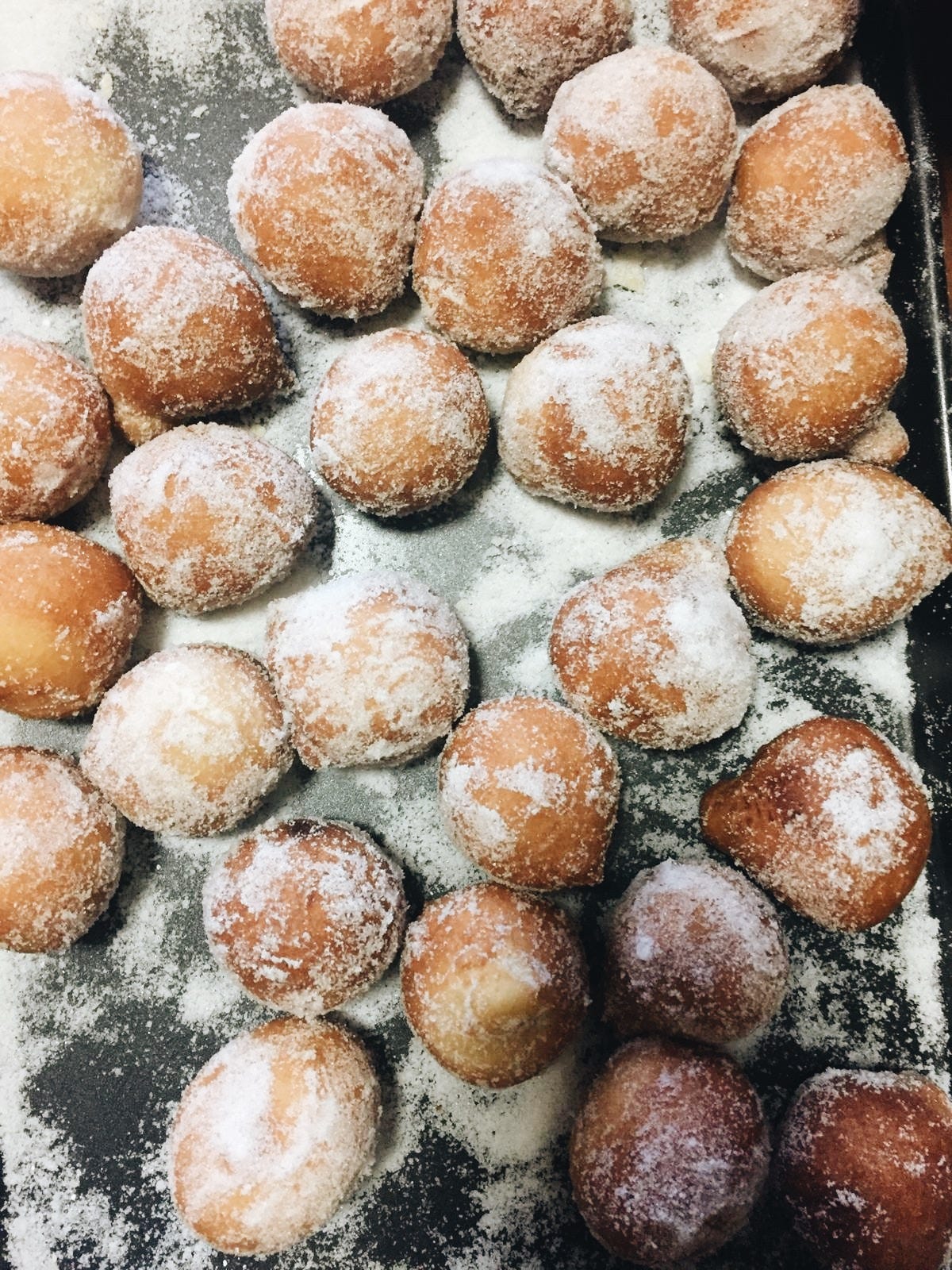Speaking of religious holidays and saints, Carnevale comes in like a wrecking ball, according to peasant traditions, 11 days after the official end of Christmas aka the Epiphany celebrated on the 6th of January. You have a little under two weeks of soup, salad and digiuno as part of your post-holiday recovery programme before the calendar flips to the 17th of January to open the celebration of Sant’Antonio Abate. When the clock strikes midnight fried sugary confections start falling from the sky to cover every surface like the first season’s snow.
I was reminded of this as I slowly sipped my lactose-free cappuccino in a daze-like state at a local bar after dropping the kids off at school. The owner was methodically hanging masks and streamers from the door and forgetting how time moves quickly, I whispered, ‘Oh my God, you are kidding me.’
You would nearly get festive whiplash here in Italy because the minute you have digested your Christmas dinner there is something new to celebrate.
‘What do you mean we have to go back and eat again!?’ This was my desperate plea as we left a late Christmas lunch with Riccardo’s family during our first year together. I remember feeling like I might spontaneously combust. Having been taught that refusing food as a guest in someone’s house was bad manners was not on my side. We then took a very long disco nap before returning to consume steaming plates of Cappelletti in brodo and to engage in hours of card games as part of the second round.
I remember wondering if Italians ever suffer a certain type of fatigue from these rhythms of cooking, eating and celebration, but this modo di essere runs deeper than the river Tiber beyond ancient Rome.
‘It is difficult to establish the birthplace of this festival celebrated all over the world: it may have begun in India and been brought from there through Asia Minor to the Mediterranean. The handsome Greek god Dionysus became the flaccid, florid-faced, almost effeminate Roman Bacchus. His curly hair wreathed in vine leaves and ivy, he rode a wagon, accompanied by satyrs and bacchants, across the whole ancient world, the center of one of the most popular and enduring cults of antiquity. In his honor, the ancient Romans instituted the Saturnalia, celebrated between the end of December and the beginning of January. Tradition traces the Roman Carnival back to these raucous festivals, in which young and old, without caste or class distinction, abandoned themselves to merrymaking and banquets’ - Oretta Zanini De Vita, Popes, Peasants and Shepherds - Recipes and Lore from Rome and Lazio
The historical evolution of Carnevale in Rome which Zanini De Vita details in her book is quite fascinating. What remains consistent is opulence and pomp, excess and debauchery trickling down from the upper echelons of society and the Church to be enjoyed by the masses and drawing the rich and powerful from all over the world. Why has this celebration survived through the ages? One might speculate that it is because of our human penchant for conviviality, indulgence and what some might call ‘sin’.
Then there is the story of the food created and consumed as an expression of this period. Zanini De Vita goes on to tell us that ‘Carnival lasted a different period of time every year, but always coincided, by definition, with the period just before the beginning of Lent. The word carnevale itself means farewell (vale) to meat (carne).’
And from the luxurious lavish banquets of the aristocrats at court to the taverns and food shared and consumed on the street remains the sugary, soft and more often than not fried modern-day treats that have also evolved within their own territories and stories. Some of the most popular are le frappe also known as chiacchiere with more than a handful of other names differing throughout the regions. These are crunchy yet delicate fried strips of pastry covered with sugar. Then there are castagnole in the form of sweet fried dough or choux pastry filled with sweet ricotta and various forms of pastry cream. Here in Rieti, you will also find castagnole stained with the sour black cherries that topped the chocolate cake recipe which I shared a few weeks ago.
‘The recipe for castagnole is very old: in the state archives of Viterbo a manuscript volume from the eighteenth century was found in which four recipes for castagnole are described, one of which involves baking them in the oven’ as cited by ‘The cuisine of the Bel Paese’ written by TOURING CLUB - ITALY together with the Accademia Italiana della Cucina which gives us one recipe from Lazio and another from le Marche:
‘Whatever the variant, their basic recipe is very ancient and unchangeable: their name, which comes from the fruit of the chestnut tree, can be found in the seventeenth-century recipe books of the D'Angiò family and in those of the Farnese family from the early eighteenth century’.
Last year, Valentina Solfrini who is from le Marche, wrote about her family's baked castagnole. I highly recommend that you read this eloquently written piece not only for the elegant recipe and images, but also for the way that she details the history, beauty and symbolism which lies beyond. She also highlights the interesting use of lard in rural kitchens for frying as a byproduct of the post-Christmas pig slaughter. This traditional practice also runs through the rural kitchens of Sabina.
Growing up in New England, the shape and smell of castagnole brings me back to my first job in a retro donut joint that I acquired when I was a mere 14 years of age (sans the horrible uniform thank God). My role involved slinging seasonal donuts (pumpkin spice anyone?) to retired men and soccer moms who bought trays of small round unleavened (and by this I mean prepared without yeast) ‘donut holes’ to feed their sweaty uniformed children.
Castagnole while similar in shape and size, are so much more than your average donut ball. As always variations are at the hand of each cook who perfume their dough with things like liqueur, vanilla and citrus. Local olive oil and the sunny yolks of farm fresh eggs create an alchemy of battered liquid gold that is lovingly embraced by a pan of hot oil.
As a celiac, I used to look longingly at these festive desserts in local pasticcerie but one afternoon, after a check-up with our first baby, I asked Riccardo to drive me across Rome to check out Pasticceria Napoleoni Gluten-Free. It was Carnevale, and the heavens opened up and angels started singing as I waddled in the door. I found a very long queue of people shouting out their orders to reduce the mountains of feathery light frappe and castagnole senza glutine (and probably also senza lattosio) that lay before my eyes. Patrons were eager and delighted to walk away with their shiny golden trays delicately wrapped and filled to the brim before shifting down into the season of magro.
Here in Rieti, locals can enjoy these and other seasonal treats thanks to our local bar and pasticceria Cristallo who has also adopted the Gzero gluten-free brand.
Buying these confections at your local pasticceria is always a pleasurable and convenient thing, but the truth is that nothing can beat the smell that permeates the air and the hot fresh taste that comes with the homemade versions of these Carnival desserts.
My recipe for gluten and dairy-free castagnole, which provides enough to please a small crowd, was developed in our Irish kitchen over a handful of years ago as it was important for me to keep these traditions alive within our family when these ready-made indulgences were out of reach. Inspired by local recipes here in Sabina, these castagnole are perfumed with orange and Cognac.
I remember Riccardo recounting his castagnole trauma of years past after biting into a warm castagnola glistening with hot sugar. There are many places that make them without love and attention to detail in order to meet demand. The result often produces a hard texture ‘which would be enough to break your neighbours window’. I hope you find these to be quite the opposite.
This recipe has the same ingredient profile as my Chocolate Chestnut Olive Oil Cake. I also use sweet, nutty and protein-packed chestnut flour (the flour of the poor) to create a harmony of flavour here. I will be making this recipe over the weekend and I hope that you will too. Between these and next Tuesday’s crespelle/crêpes (I will also share this recipe!) we should get to the bottom of our bags of flour in no time.
Castagnole
Castagnole di Carnevale
Serves 8-10
GF + DF + VE
Ingredients:
450g GF flour blend
200g chestnut flour
100ml extra virgin olive oil
1 tbsp baking powder
3 free-range eggs
150g raw cane or granulated sugar
150ml almond milk
1 tsp vanilla
1 small unwaxed orange, juice and zest
1 tbsp of Cognac
Sea salt, a pinch
1l sunflower oil, for frying
Optional: Powdered sugar to finish if you do not prefer granulated
Method:
Mix your dry ingredients in a large bowl. Make a well in the centre and add your wet ingredients whisking them together with a fork. Gently bring the dough together with a soft spatula or wooden spoon until combined.
Add your oil to a deep medium sized frying pan filling it 3/4 of the way. Heat over medium-low heat until a small piece of dough sizzles.
Use 2 tablespoons to form a smalls ball of dough and gently drop them into the oil one at a time without crowding the pan. Fry until golden 3-4 minutes and lift them out with a slotted spoon.
Drain on a tray covered with paper towel and sprinkle with granulated or powdered sugar while they are still warm.









